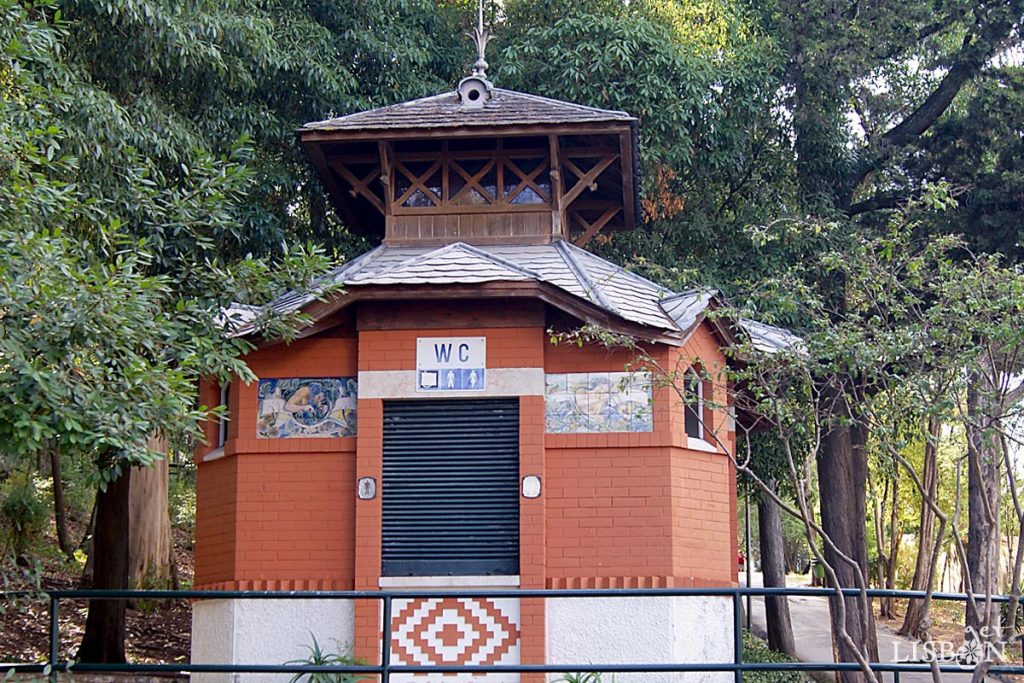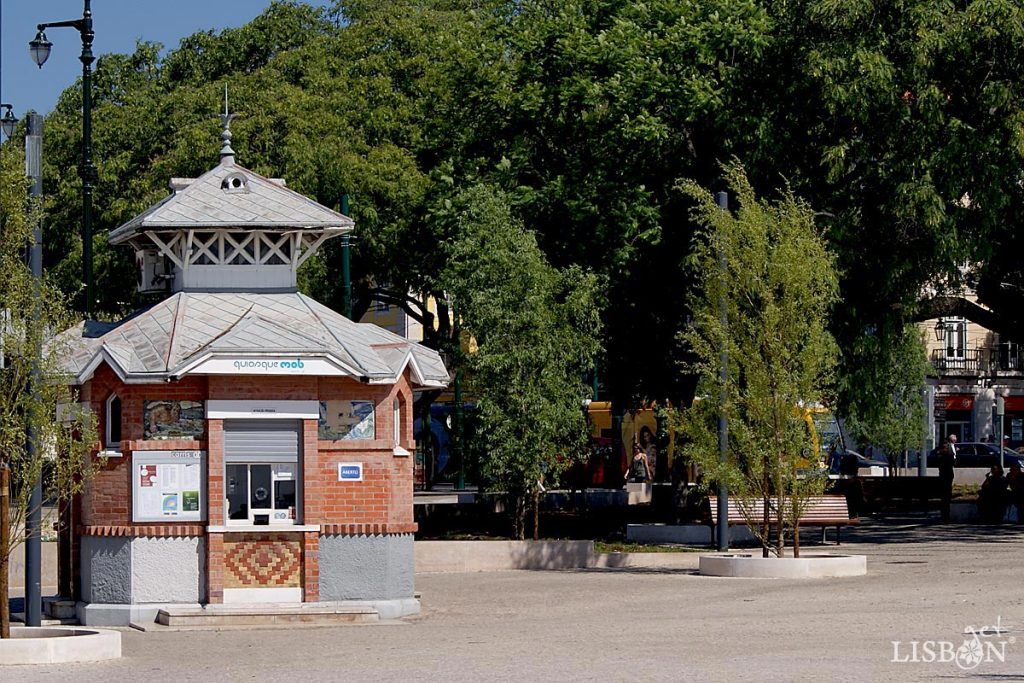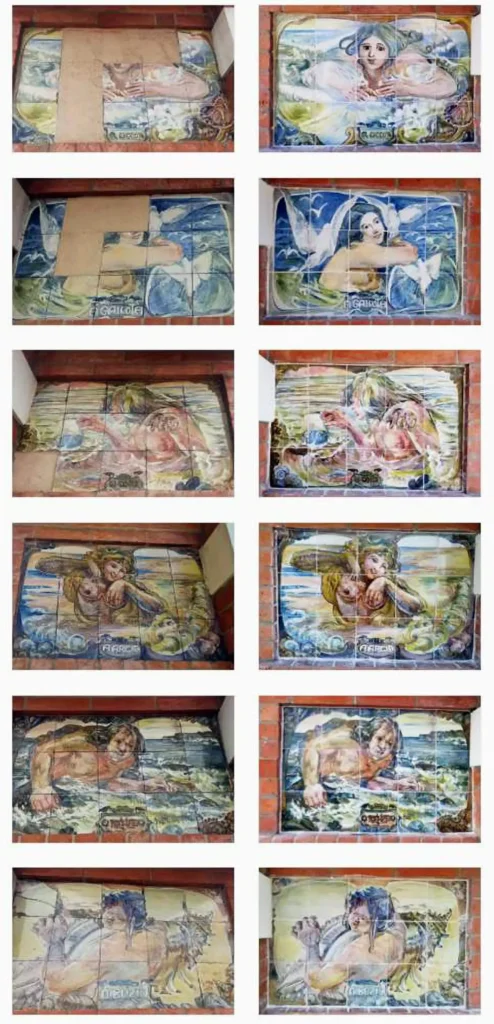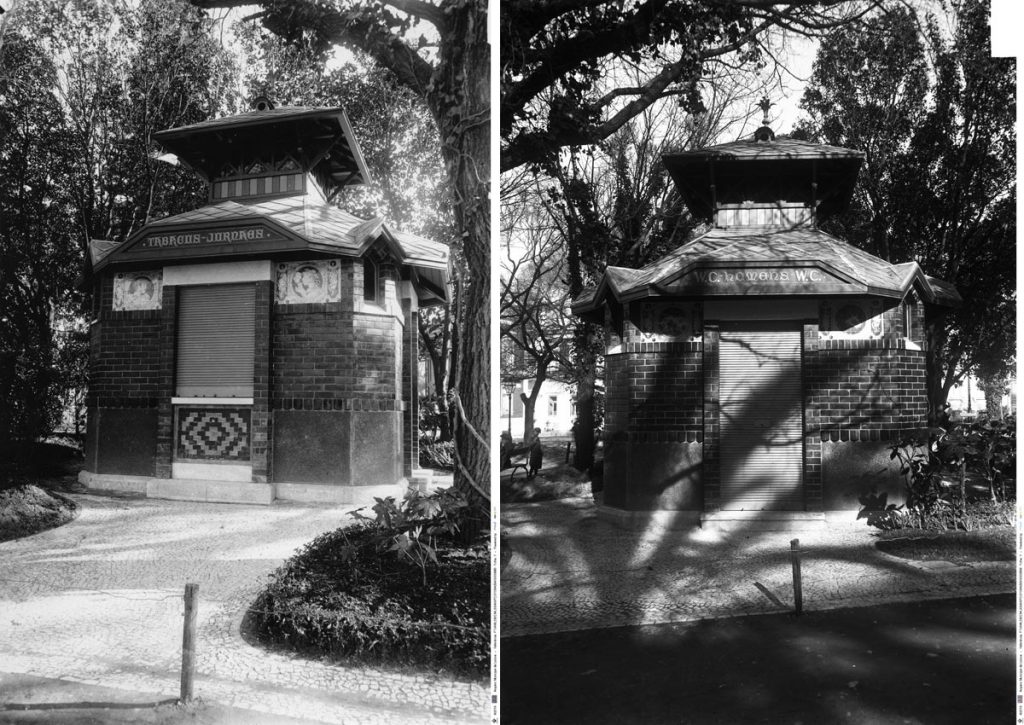Updated on 23 October 2024
Original article published on 3 April 2019
Today we bring to you the old concept of public toilet, the WC kiosks of Lisbon. These are true design pieces with an artistic value that’s worth preserving.
We’ve had the opportunity to talk about the old public urinals that this city still maintains. But this article’s about another equipment of the early 20th century of which four exemplars still remain.
We’re also going to reveal you the location of another kiosk that has already been demolished and that we were able to find in old photos.
Get to know Lisbon’s historic neighbourhoods in a guided tour and discover unmissable places of this magnificent city.
An Innovative Project

The WC kiosks of Lisbon are curious brick pavilions that we can find in four public parks. All of them feature tilework that deserves to be mentioned, but let us first get an understanding of what this urban equipment is.
It was the year of 1913 when the architect José Alexandre Soares presented to the City Council of Lisbon a project for public toilet kiosks for women. These were destined to be placed in squares and public parks and included annexes for the sale of flowers and newspapers.
The proposal of the project clearly mentions that the materials used take into account economic factors and temperature changes. Nevertheless, despite these concerns, the project doesn’t exclude aesthetics and artistic decoration.
The adopted model, just like the bandstands of Lisbon, follows the style of the Kiosco of Persian origin, the style of the turn of the 19th century. This model consists of a covered building, with generally open walls, which was common at the time in gardens, meant for resting or providing shelter.
However, while the bandstands feature the innovative architecture of iron, these kiosks feature a masonry structure with traditional materials such as wood and solid brick.
These square-shaped pavilions feature two-level roofs, which give them an oriental aesthetic. Each side has a door in between counters. Flanking those open sides there is a reserved space for tile panels that are worth checking out.


The 4 WC Kiosks of Lisbon
We don’t know how many of these WC kiosks were built, but we can show you the four that have been preserved, renewed or that have new functions.
Benfica – Silva Porto Park

Situated right at the entrance of Silva Porto Park, widely known as Mata de Benfica (directly translated to Benfica Woods), we find the first of the WC kiosks of Lisbon. It features eight magnificent 3×5 tile panels, signed and dated 1915.
We are before a tilework from the painter José António Jorge Pinto, an artist who was notable for his works in the style Art Nouveau. The figurative naturalistic designs, with sinuous lines and undulating rhythms characteristic of this style, surprise us with the chromatic richness and the sensuality of the themes.

Personifications of the Fountain, the Woods and of the Hunt go along with the expression Loves me, Loves me Not, a Lot, a Bit, or Not At All.
The ideas of freshness, green, conquest and of falling in love are coherent with the fruition of nature in the woods and the experience of strolling around.

Cais do Sodré – Roque Gameiro Garden

The second of the WC kiosks of Lisbon is located at Cais do Sodré. It belongs to Carris (public transport company) and today serves not only as a restroom for the exclusive use of its drivers but also as a kiosk for selling transport tickets.
When this article was first published in April 2019, regarding the tile panels present there, we mentioned the following:
“It only features six tile panels, two of which have several gaps.
They’re from the same author as the previous ones and are signed and dated 1916.
Once again, the theme of the images represented are related to the surrounding environment. In this case, the proximity to the Tagus river.
The personifications Sand, Sea, Rock, Conch, Seagull and Wave are presented in compositions with the characteristics of the previous ones. Wide brushstrokes, sinuous lines and vibrant colours surprise us, making it a shame the existence of gaps and the total absence of two panels that have certainly existed in the past.”
Today, we can add that the tiles were likely produced at the Campolide factory, founded in 1896.
Acknowledging that this is a “unique tile ensemble in terms of theme and technique by a renowned artist of the Art Nouveau movement, which holds significant heritage value within Lisbon’s existing tile heritage,” and given the advanced state of deterioration, Carris decided to proceed with their restoration.
Thus, after unsuccessfully seeking information on the missing panels, the painting and creation of two new panels, The Wind and The Octopus, were entrusted to ceramist Helena Castela. Additionally, the same artist filled in the gaps, some of considerable size, paying particular attention to the original colour and Jorge Pinto’s style to achieve a stylistic unity as close as possible.
In our view, opting for this type of restoration entails various risks, as we pointed out in A Reflection on the Restoration and Reconstruction of the Artistic Heritage. Nonetheless, the effort to preserve this heritage is commendable.
However, we would like to suggest that Carris make available, in a visible location, an information panel detailing a bit of the history of this structure, highlighting the intervention carried out in 2023, what is original, and what is modern, so that passersby can fully appreciate what they are observing.


Arroios – Constantino Garden

The pavilion of Jardim Constantino has eight panels of tiles that have no signature or date and whose composition differs from the previous WC kiosks of Lisbon.
This time the author, who we believe to be the same, opted for a yellow and blue frame configuration, the same for all panels, but with different central motifs.

Four of the panels depict women of different ages in soft-line drawings, which remind us of a certain sophistication that perhaps the garden, at the time modern, imposed.
The other four panels present two repeated drawings. In one of them we can see a pile of books, newspapers and tobacco and in the other, bottles and glasses, which suggests these products were sold here.
Today, it still provides the same service.
Poço Bispo Garden

The last WC kiosk of Lisbon is situated in the garden of the David Leandro da Silva Square, in Poço Bispo and has a curious particularity.
The older photos of this equipment reveal that the tile spaces are empty, which leads us to believe that tiles may have never been made specifically for this construction.
At the time, the East zone of Lisbon was highly industrialised and the fact that this kiosk was to be used by workers, the absence of tiles doesn’t surprise us.
It’s a shame since the surrounding space is replete with the thematic and expression of the painter José António Jorge Pinto’s panels. We can imagine that the artist, inspired by the factory and the river workers, would’ve produced beautiful panels.

Now the tile spaces have been filled with works from 1992 reproducing some of the tiles from Constantino Garden, but with less quality.
This kiosk also still provides the same service.
| Never miss another article | Subscribe here |
Príncipe Real Garden, A Lost Exemplar

In two old photos we were able to find a fifth WC kiosk, which has unfortunately already been demolished. It used to be located in the Príncipe Real Garden and, just like the others, it featured tile panels.
The black and white pictures prevent us from admiring its colours, but the drawings appear to be from the same artist and have a similar style to the ones of the Constantino Garden, which emphasises the concept of the compositions being related to the surrounding space.
In one of the panels we can see a paperboy selling newspapers and in another a sailor lighting a cigarette. The idea suggested in the drawings is reinforced in a sign that announces tobacco and newspapers in letters Art Nouveau.
Unfortunately, we’re not able to clearly see the tiles of the other façade, but we believe it’s a landscape with the same frames as the previous tiles.
We don’t know the year of its demolition, we can only grieve over it. Have the tiles been saved?… We’d like to think so!
After reading this article, when you come across one of these WC kiosks of Lisbon you certainly won’t forget to admire these beautiful pieces of art and design, testimonies of a time when functionality, aesthetics and art were one.
We hope they’ll be preserved for a long time.
The project getLISBON has been very rewarding and we want to continue revealing the singularities of fascinating Lisbon.
Help us keep this project alive!
By using these links to make your reservations you’ll be supporting us. With no extra costs!
• Looking for a different experience? We can create a customised itinerary based on your interests. Contact us!
• Or if you prefer tours and other activities in various destinations, take a look at GetYourGuide.
• Save time and money with a flexible Lisbon Card!




